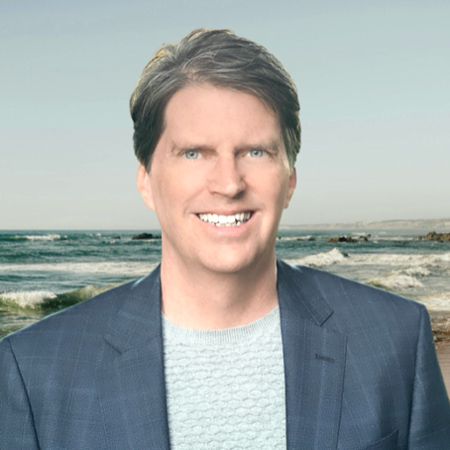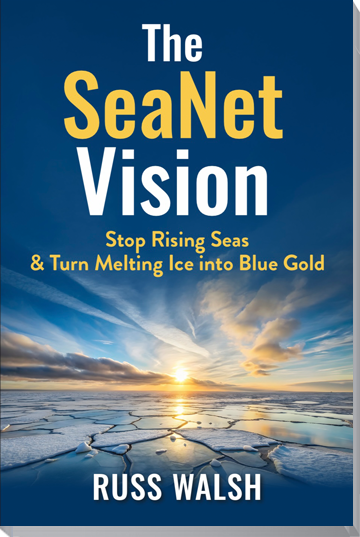About
The Author

Russ Walsh – Technology Executive, Climate Solutions Trailblazer, and Author of The SeaNet Vision
Russ Walsh is an innovative technology executive with more than 30 years of experience advising and leading global organizations, including IBM, GE, Apple, Google, Facebook, and more than 100 startups. His expertise spans cybersecurity, risk & compliance, and the design of critical infrastructure systems that support some of the world’s most essential industries.
From 2016 to 2022, Russ served at General Electric (GE), where he led major corporate compliance initiatives focused on cybersecurity, privacy, and sustainability. During the COVID years, he also spearheaded research efforts into wildfire detection and response, exploring how GE’s aviation and aerospace capabilities could be applied to one of the planet’s leading threats.
It was while at GE that Russ uncovered an even greater challenge — global sea level rise. Initially skeptical, he immersed himself in the science, reviewing reports from NASA, National Geographic, BBC, and leading universities, as well as meeting with global experts and policy leaders. What he discovered was sobering: sea levels are rising at an accelerating pace, threatening coastal cities, nations, and billions of lives. Yet, despite decades of research, no practical large-scale solution was being advanced.
That realization led to the creation of The SeaNet Vision — a bold and actionable concept to redirect rising oceans into arid regions such as Australia and the Sahara, creating new inland seas, forests, and communities while relieving pressure on the world’s coastlines. Climate leaders, academics, and industry experts have already recognized this concept as a potential game-changer.
Today, Russ is the Founder of the SeaNet Vision Initiative and Chief Revenue Officer at CyberSurv, a forward-thinking cybersecurity consultancy. He continues to engage with leaders in academia, government, and construction on building the world’s largest and most important infrastructure project. His upcoming book, The SeaNet Vision: Stop Rising Seas and Turn Melting Ice into Blue Gold (Q1 2026), captures this groundbreaking idea and lays out a path forward for humanity.
The SeaNet Vision
In 2020, while leading cybersecurity risk and compliance at General Electric in Silicon Valley, I found myself — like many others — isolated during the pandemic. With my wife overseas caring for her parents and GE calling for new ideas, I turned my energy toward researching wildfire detection and response. That work opened my eyes to an even greater challenge: global sea level rise.
At first, I considered it a minor issue. But the more I studied, the clearer the picture became. Seas are rising by more than an inch per decade, threatening to climb three feet by 2100 — and potentially over 200 feet if all polar ice melts. Indonesia is already relocating its capital because of sinking land and rising seas. Venice, Miami, and countless other coastal cities face existential threats.
What struck me most wasn’t the danger itself, but the lack of solutions. Reports and documentaries from NASA, BBC, National Geographic, and leading universities ended the same way: with a doomsday forecast, urging humanity to retreat inland.
That wasn’t good enough.

I began researching a bold alternative: redirecting rising seas into inland deserts like Australia and the Sahara. The concept, which I named the SeaNet, could create vast new lakes, forests, and communities — while protecting coastal populations worldwide. Early discussions with climate researchers, governments, and construction leaders suggest it could be the game-changer humanity needs.
Today, I’m finalizing my book, The SeaNet Vision: Stop Rising Seas and Turn Melting Ice into Blue Gold (Q1 2026). But this isn’t just a book — it’s a blueprint for the world’s most ambitious construction project.Imagine deserts transformed into green landscapes. Imagine new inland seas supporting thriving cities. Imagine the next generation working not just in software, but in engineering, construction, and water management at a scale humanity has never attempted.
The SeaNet Vision is more than research. It’s an invitation — to rethink what’s possible, to solve one of our greatest threats, and to build a future worth passing on.
We Believe in A Collaborative Approach
Ocean Conservation
Highlighting the importance of ocean conservation efforts, showcasing key projects, and outcomes.
Community Engagement
Demonstrating how the organization involves local communities in ocean conservation through education.
Research and Innovation
Showcasing ongoing research projects, technological innovations to ocean preservation.

Real People. Real Impact.
WCK’s work is guided by our belief that food is a universal human right. Both in the communities we serve and in our daily workspace, we uphold and rely on our values to direct us toward fulfilling our shared purpose.
Without peace, development gains do not hold. Without peace, delivering humanitarian aid risks further suffering. Without peace, people have more difficulty exercising agency, seizing opportunity, and realizing their full potential
